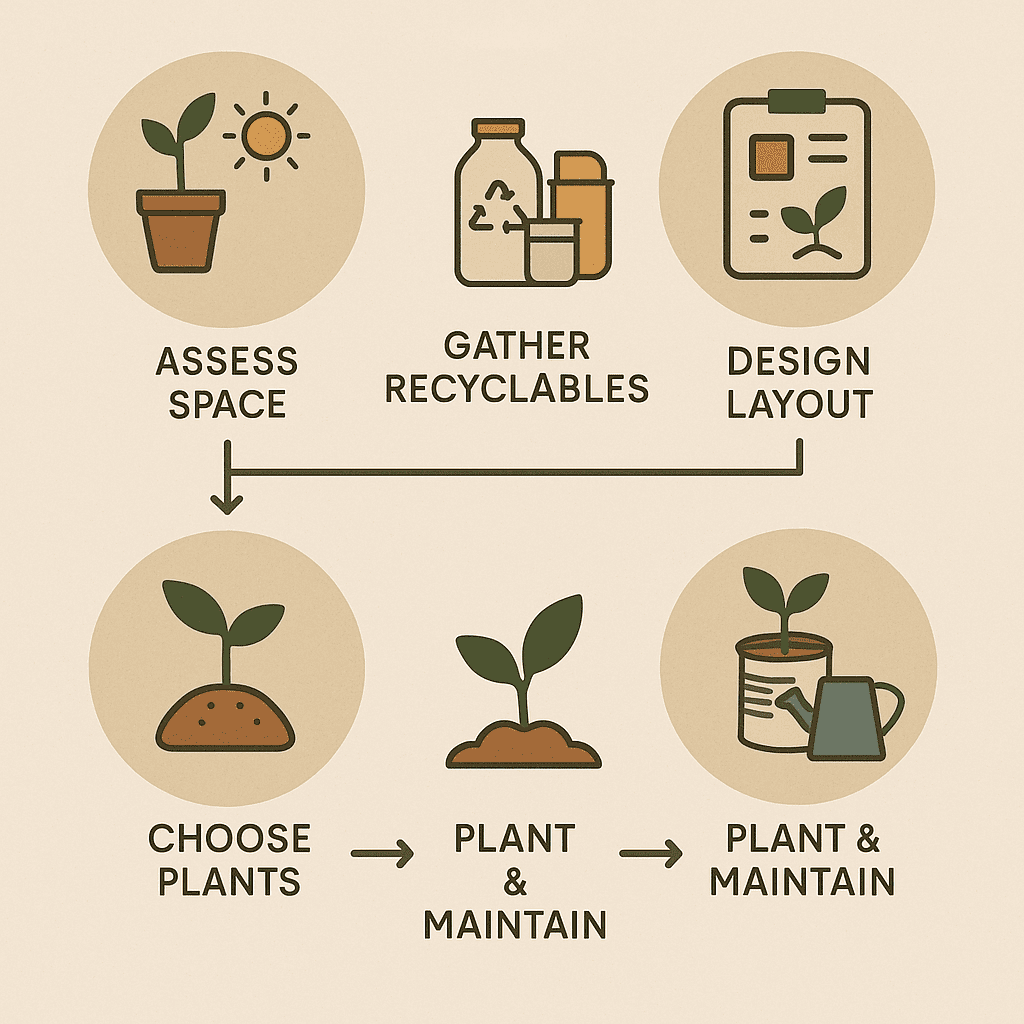Urban gardening is gaining popularity as people look for sustainable ways to grow their own food in limited spaces. One of the smartest, most eco-friendly methods is learning how to use recycled items for urban gardening. This approach not only reduces waste but also saves money and encourages creativity. Whether you live in an apartment or have a small balcony, you can create a thriving garden using materials you already have at home.
Why Recycled Urban Gardening Makes Sense
Urban environments often lack the space or resources for traditional gardening. Recycled urban gardening solves both problems at once by turning household waste into productive tools.
Benefits of Using Recycled Items:
- Lowers gardening costs significantly
- Reduces household waste
- Promotes environmental sustainability
- Encourages creative problem-solving
- Makes gardening accessible in small or paved spaces
Best Recycled Items to Use in Urban Gardens
1. Plastic Bottles
Great for making vertical planters, mini greenhouses, and self-watering systems.
How to use:
- Cut bottles in half for mini planters.
- Poke holes in the cap and fill with water to create a drip irrigation system.
- Hang horizontally with the sides cut open to plant herbs or flowers.
2. Old Buckets or Paint Cans
Perfect for growing deep-rooted plants like tomatoes or carrots.
Tips:
- Drill drainage holes at the bottom.
- Paint the exterior for a decorative touch.
- Add compost and lightweight potting soil.
3. Wooden Pallets
Ideal for creating vertical garden walls or raised beds in patios.
How to use:
- Sand and seal the wood to avoid rot.
- Fill with soil between the slats for herbs or succulents.
- Lean against a wall or fence for stability.
4. Tin Cans
Great for herbs or small flowers on windowsills or balconies.
Instructions:
- Remove labels and make drainage holes.
- Place small rocks at the bottom before adding soil.
- Use twine to hang from balcony railings.
5. Egg Cartons and Toilet Paper Rolls
Perfect for seed starting and indoor sprouting.
How to use:
- Fill with seed-starting mix and plant one seed per cell.
- When seedlings are strong, transplant the whole unit into a larger pot.
6. Old Furniture (Drawers, Shelves, Chairs)
Can be transformed into rustic garden displays or planting stations.
Ideas:
- Use drawer space for shallow-rooted greens.
- Remove seat cushions and insert pots into chair frames.
- Place outdoors for visual appeal and practicality.
Step-by-Step: Starting Your Urban Garden with Recycled Items
Step 1: Assess Your Space
- Look for balconies, windowsills, rooftops, or small patios.
- Consider sunlight availability (most vegetables need 6+ hours).
Step 2: Gather Recyclables
Collect suitable items like:
- Plastic bottles
- Metal cans
- Wood scraps
- Fabric bags
- Food containers
Clean and inspect all materials for safety and durability.
Step 3: Design Your Layout
- Use vertical space with hanging planters or pallet walls.
- Arrange containers to maximize light exposure.
- Consider mobility if you’ll need to move pots indoors.
Step 4: Choose the Right Plants
Begin with easy-to-grow options such as:
- Basil, mint, parsley (for small containers)
- Lettuce, spinach (for shallow boxes)
- Tomatoes, peppers (for buckets or large cans)
Step 5: Prepare Soil and Drainage
- Use a lightweight potting mix mixed with compost.
- Ensure each container has proper drainage holes.
Step 6: Plant and Maintain
- Water regularly but avoid overwatering.
- Add mulch to retain moisture.
- Monitor for pests, especially in small urban environments.

Eco-Friendly Watering Ideas Using Recyclables
Water conservation is essential in urban areas. Here’s how recycled items can help:
- Plastic bottles: Create slow-drip systems by inserting pierced bottles near plant roots.
- Old sponges: Place at the bottom of containers to retain moisture.
- Cooking water: Reuse cooled vegetable cooking water as a natural fertilizer.
Decorating with Upcycled Garden Features
Sustainability doesn’t mean sacrificing beauty. You can make your garden visually appealing using:
- Painted tin cans and buckets
- Handwritten plant labels from popsicle sticks
- Hanging macramé made from old t-shirts or rope
- Pallet walls with a mix of flowers and herbs for color
These elements not only make your garden functional but also charming and unique.
Common Mistakes to Avoid
- Using untreated materials: Always clean and sanitize recycled containers before planting.
- Skipping drainage: Plants need airflow and excess water release—always make drainage holes.
- Overloading small structures: Avoid putting too much weight on balconies or shelves.
- Neglecting sun exposure: Monitor light daily to ensure plants get the hours they need.
For more sustainable inspiration, explore our guide on home gardening ideas using recycled materials.
Conclusion: Turn Trash into Growth
Now that you’ve learned how to use recycled items for urban gardening, it’s time to turn everyday waste into a vibrant, productive space. From plastic bottles to old drawers, almost anything can become a garden tool with a little imagination and care.
Start your urban garden today by collecting recyclable materials around your home. With minimal cost and a big impact, you’ll create not just a garden—but a sustainable lifestyle.
FAQ – Frequently Asked Questions
Is it safe to grow food in recycled containers?
Yes, as long as the container is clean, food-safe (no toxic chemicals), and has proper drainage.
What are the best vegetables to grow in recycled containers?
Leafy greens, herbs, cherry tomatoes, and radishes are perfect for small, shallow containers.
Can I use plastic containers for long-term planting?
Yes, but choose BPA-free plastics and avoid those that degrade quickly in sunlight.
Need tools to upcycle your garden? This DIY urban gardening kit on Amazon includes containers, hand tools, and compostable liners—perfect for recycled setups.
